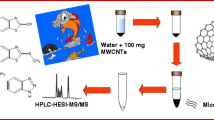Abstract
The use of multiwall carbon nanotubes (MWCNT) as an efficient solid extractor in preconcentration/cleanup studies for tin determination in water samples by electrothermal atomic absorption spectrometry (ETAAS) is proposed. In the proposed method, tin adsorption onto MWCNT was carried out by percolating the solution previously buffered (pH 4.79 with 0.24 mol L−1 acetic acid/acetate buffer) at 4.0-mL min−1 flow rate, followed by elution with 1.0 mL of 2.7 mol L−1 HNO3. Factors such as sample pH, preconcentration/cleanup flow rate, type and concentration of eluent, and buffer concentration were appraised and optimized from chemometric tools based on fractional factorial design and Doehlert design. A limit of detection of 0.73 μg L−1 and precision (n = 8) assessed as relative standard deviation of 8.6% and 7.0% for tin concentration of 8.0 and 43.0 μg L−1, respectively, were achieved. Foreign metallic ions (Ni2+, Pb2+, Co2+, Zn2+, Cd2+, Mn2+, and Fe3+) were checked as potential interferents, and no interference was observed up to an analyte/interference ratio of 1:10 (m/v). Direct tin determination by ETAAS in water samples containing high salt amount is drastically affected by background signal. However, previous cleanup of sample by MWCNT has promoted a significant improvement and makes the method useful for tin monitoring in water samples (mineral, lake, mine, and natural waters) by ETAAS. Quantitative recovery values ranging from 91.5% to 103.0% attested the applicability of the proposed preconcentration/cleanup for tin determination in water samples.





Similar content being viewed by others
References
Abollino, O., Aceto, M., La Gioia, C., Sarzanini, C., & Mentasti, E. (2002). Voltammetric determination and speciation of inorganic and organometallic tin. Electroanalysis, 14(15–16), 1090–1097.
Al-Degs, Y. S., Al-Ghouti, M. A., & El-Sheikh, A. H. (2009). Simultaneous determination of pesticides at trace levels in water using multiwalled carbon nanotubes as solid-phase extractant and multivariate calibration. Journal of Hazardous Materials, 169, 128–135.
Arpadjan, S., Vuchkova, L., & Kostadinova, E. (1997). Sorption of arsenic, bismuth, mercury, antimony, selenium and tin on dithiocarbamate loaded polyurethane foam as a preconcentration method for their determination in water samples by simultaneous inductively coupled plasma atomic emission spectrometry and electrothermal atomic absorption spectrometry. Analyst, 122, 243–246.
Barbosa, A. F., Segatelli, M. G., Pereira, A. C., Santos, A. S., Kubota, L. T., Luccas, P. O., et al. (2007). Solid-phase extraction system for Pb(II) ions enrichment based on multiwall carbon nanotubes coupled on-line to flame atomic absorption spectrometry. Talanta, 71(4), 1512–1519.
Bonfilio, R., Tarley, C. R. T., Pereira, G. R., Salgado, H. R. N., & Araújo, M. B. (2009). Multivariate optimization and validation of an analytical methodology by RP-HPLC for the determination of losartan potassium in capsules. Talanta, 80, 236–241.
Fang, Z. (1993). Flow injection separation and pre-concentration (1st ed.). Weinheim: Wiley.
Ferreira, S. L. C., Santos, W. N. L., Quintella, C. M., Neto, B. B., & Bosque-Sendra, J. M. (2004). Doehlert matrix: a chemometric tool for analytical chemistry—review. Talanta, 63, 1061–1067.
Ghaseminezhad, S., Afzali, D., & Taher, M. A. (2009). Flame atomic absorption spectrometry for the determination of trace amount of rhodium after separation and preconcentration onto modified multiwalled carbon nanotubes as a new solid sorbent. Talanta, 80, 168–172.
Greger, J. L. (1988). Tin and aluminum. In K. T. Smith (Ed.), Trace minerals in foods. New York: Marcel Dekker.
Hodge, V. F., Seidel, S. L., & Goldeberg, E. D. (1979). Determination of tin(IV) and organotin compounds in natural water, coastal, sediments and macro algae by atomic absorption spectrometry. Analytical Chemistry, 51, 1256–1259.
Katsumata, H., Matsumoto, T., Kaneco, S., Suzuki, T., & Ohta, K. (2008). Preconcentration of diazinon using multiwalled carbon nanotubes as solid-phase extraction adsorbents. Microchemical Journal, 88, 82–86.
Long, G. L., & Winefordner, J. D. (1983). Limit of detection. A closer look at the IUPAC definition. Analytical Chemistry, 55, 712–724.
Maguire, R. J., Tkacz, R. J., Chau, Y. K., Bergent, G. A., Wong, P. T. S., Chau, Y. K., et al. (1986). Occurrence of organotin compounds in water and sediment in Canada. Chemosphere, 15, 253–274.
Nacano, L. R., Segatelli, M. G., & Tarley, C. R. T. (2010). Selective sorbent enrichment of nickel ions from aqueous solutions using a hierarchically hybrid organic–inorganic polymer based on double imprinting concept. Journal of the Brazilian Chemical Society, 21, 419–430.
Tarley, C. R. T., Barbosa, A. F., Segatelli, M. G., Figueiredo, E. C., & Luccas, P. O. (2006). Highly improved sensitivity of TS-FF-AAS for Cd(II) determination at ng L–1 levels using a simple flow injection mini-column preconcentration system with multiwall carbon nanotubes. Journal of Analytical Atomic Spectrometry, 21, 1305–1313.
Thompson, S. E., Burton, C. A., & Quinn, D. J. (1972). Concentration factors of chemical elements in edible aquatic organisms. University of California, Lawrence Livermore Laboratory, Biomedical Division, Livermore, CA.
Tsogas, G. Z., Giokas, D. L., & Vlessidis, A. G. (2009). Graphite furnace and hydride generation atomic absorption spectrometric determination of cadmium, lead, and tin traces in natural surface waters: Study of preconcentration technique performance. Journal of Hazardous Materials, 163, 988–994.
Yuan, C., Jiang, G., He, B., & Liu, J. (2005). Determination of tin in water samples by using cloud point extraction and graphite furnace atomic absorption spectrometry. Microchimica Acta, 150, 329–334.
Zhang, Q., Minami, H., Inoue, S., & Atsuya, I. (2001). Preconcentration by coprecipitation of arsenic and tin in natural waters with a Ni–pyrrolidine dithiocarbamate complex and their direct determination by solid-sampling atomic-absorption spectrometry. Fresenius Journal of Analytical Chemistry, 370, 860–864.
Zhe-ming, N., Heng-bin, H., Ang, L., Bin, H., & Fu-zheng, X. (1991). Determination of tributyltin and inorganic tin in sea-water by solvent extraction and hydride generation electrothermal atomic absorption spectrometry. Journal of Analytical Atomic Spectrometry, 6, 385–387.
Acknowledgments
The authors would like to thank CNPq, FAPEMIG, and CAPES for the financial support and fellowships.
Author information
Authors and Affiliations
Corresponding author
Rights and permissions
About this article
Cite this article
Costa, H.H.V., de Fátima Lima, G., Nacano, L.R. et al. Preconcentration/Cleanup Studies of Tin from Environmental Water Samples by Oxidized Multiwall Carbon Nanotubes Packed Column and its Determination by ETAAS. Water Air Soil Pollut 217, 557–565 (2011). https://doi.org/10.1007/s11270-010-0609-4
Received:
Accepted:
Published:
Issue Date:
DOI: https://doi.org/10.1007/s11270-010-0609-4




